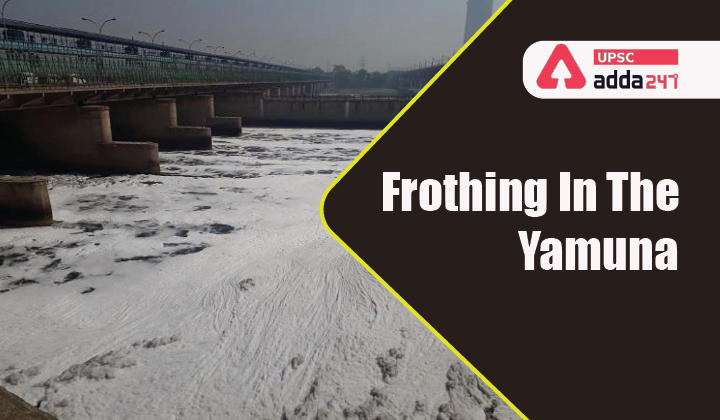Why in News?
In a repeated occurrence in the Delhi Yamuna, this year also a layer of froth has been floating over parts of the Yamuna river.
What causes frothing in the Yamuna?

- The froth is a sign of a polluted river.
- The release of untreated or poorly treated effluents, including sewage from those parts of the city that are not connected to the sewerage network and industrial waste, could lead to frothing.
- Also because Surfactants and phosphates from detergents in households and industrial laundry find their way into the river, as all the sewage is not treated.
Why does this happen at this time of the year?
- Because at this time, the river is in a lean phase and the water flow is less. Pollutants, therefore, are not diluted.
- The turbulence at the barrage near Okhla generates foam from the phosphates, etc.
What has been done about it?
- In June this year, the DPCC banned the sale, storage and transportation of soaps and detergents not conforming to the quality standards set by the Bureau of Indian Standards (BIS).
- As the now-disbanded Yamuna Monitoring Committee had recommended that such a ban be imposed.
Yamuna Monitoring Committee
- The National Green Tribunal, on July 26, 2018, had constituted the monitoring committee comprising its former expert member B S Sajwan and former Delhi chief secretary Shailaja Chandra on the cleaning of the Yamuna and had directed it to submit an action plan in this regard.
- The green panel in January had dissolved the committee after getting its recommendations.
- The Yamuna Monitoring Committee, in its fifth report submitted to the National Green Tribunal (NGT), has raised multiple issues due to which the river is still polluted, including several agencies missing deadlines related to cleaning the river and internal problems of the organisations.
- The NGT handed over the further monitoring to the chief secretaries of NCT of Delhi (and other authorities of Delhi, including DDA, DJB and Municipal Corporations), Haryana and UP.
What should be done to prevent yearly frothing?
- From the report of the Yamuna Monitoring Committee, it is clear that the major problem of preventing pollution by the discharge of sewage, industrial effluents and other pollutants remains unaddressed.
- Thus, on the part of concerned authorities in the states of Delhi, Haryana and UP, further actions in terms of the earlier orders of this tribunal as well as the current recommendations of the committee need to be taken.
- This may be overseen by the chief secretaries of the concerned states on regular basis by constituting a cell of experts on the subject for meaningful monitoring in coordination with authorities like DDA, IDMC, DPCC, DJB, etc.
- Non-adherence to timelines must result in adequate and stringent action against accountable people.
- Timely completion of projects must be ensured, otherwise, for generations, the problem will remain untackled.
- Interim measures like phytoremediation needed to be employed where the permanent solution was being delayed.
- The river rejuvenation committees of Delhi, Haryana and UP should ensure inter-departmental coordination for the execution of action plans



 TSPSC Group 1 Question Paper 2024, Downl...
TSPSC Group 1 Question Paper 2024, Downl...
 TSPSC Group 1 Answer key 2024 Out, Downl...
TSPSC Group 1 Answer key 2024 Out, Downl...
 UPSC Prelims 2024 Question Paper, Downlo...
UPSC Prelims 2024 Question Paper, Downlo...
